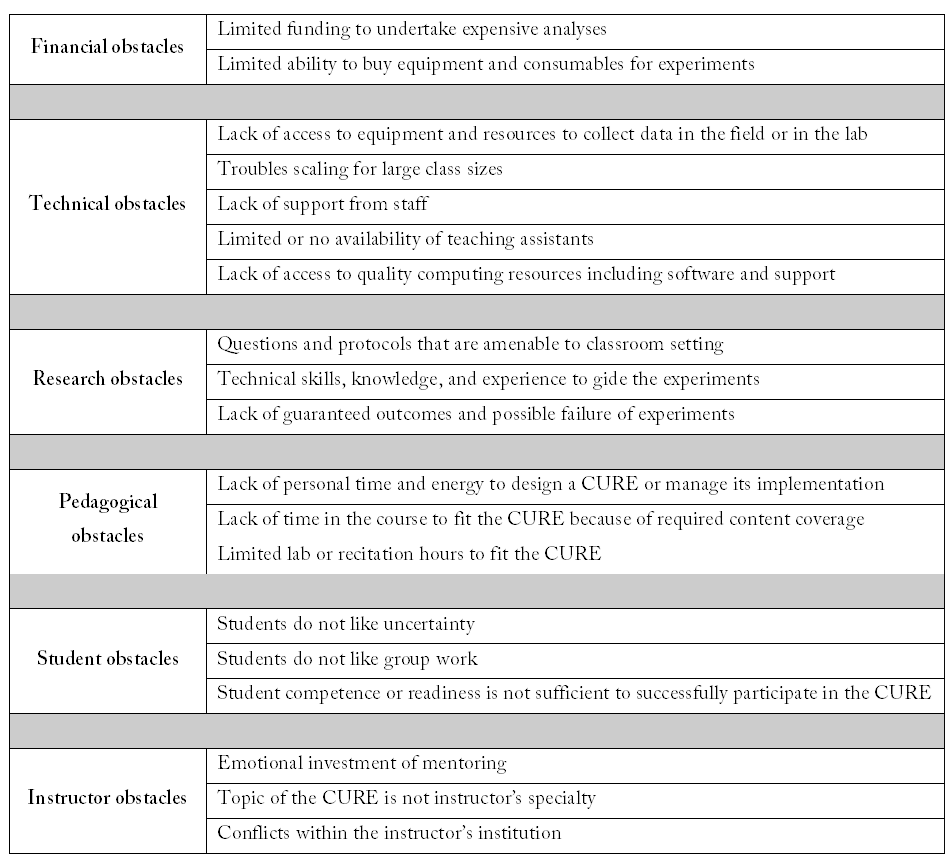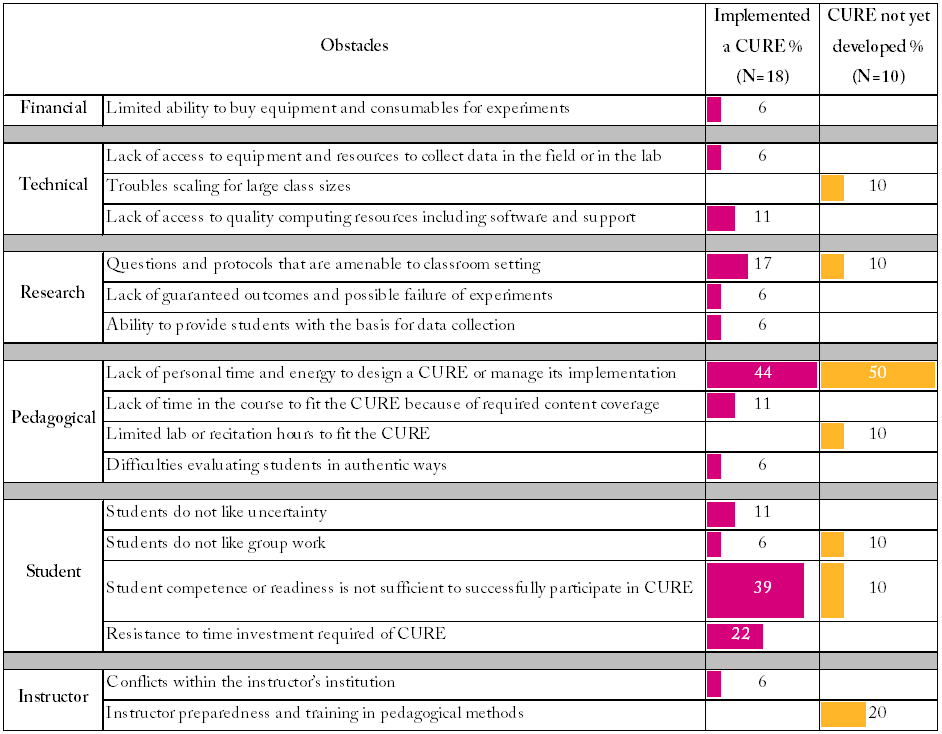G) Overcoming the challenges of CUREs
Numerous studies have focused on barriers to the design and implementation of CUREs affecting instructors. Open answer surveys and Likert-scale questions have been particularly helpful in identifying the main obstacles standing in the way of the development of CUREs (Table 18). Many of these challenges are problems for the implementation of undergraduate research in general, including mentored undergraduate research experiences (Doyle, 2002).

Other obstacles have also been mentioned in the literature. Some represent obstacles specific to CUREs, others are obstacles to undergraduate research or creative teaching in general. These obstacles include the time to publication of research projects (Turner et al., 2021), issues of identity as a teacher in environments that emphasize research productivity (Brownell & Tanner, 2012), time and emotional investment for graduate teaching assistants (Goodwin et al., 2021), fear that the CURE time will take away from content delivery and lead to detrimental effect on understanding of course concepts (Lopatto et al., 2014), the loss of favorite labs and activities not compatible wit the CURE (DeChenne-Peters & Scheuermann, 2022), and the lack of expertise of support staff (Wolkow et al., 2014).
A survey of instructors at the Ohio State University mirrors the data from the literature presented above. The open answers of (a) instructors who have developed and implemented CUREs (N=16), (b) instructors who have developed but not yet implemented a CURE (N=2), and (c) instructors who have not yet developed a CURE (N=10) were categorized in each of the 18 items presented in Table 18, or assigned to new categories to identify the challenges experienced by Ohio State instructors specifically. Instructors were able to identify more than one obstacle to their design and implementation efforts resulting in 47 coded difficulties. None, even within the group of instructors that has not implemented a CURE, expressed a lack of interest in the development of one. Because of the small number of responses associated with CUREs that have been developed, but not yet implemented, two categories are considered: CURE developed, and CURE not yet developed (Table 19).

The data from instructors at The Ohio State University are consistent with prior studies. Yet, they also provide interesting additional information. For example, the comparison between instructors who have developed (and for all but two implemented) a CURE and those who are yet to engage in this practice shows that student obstacles, particularly student preparedness and time investment, are important impediments to the implementation of CUREs; they also may be underestimated by instructors developing a CURE. These issues are usually not presented as major challenges to the development and implementation of CUREs in the literature (but see Spell et al., 2014). Yet, student attitudes are critical to learning gains (Lopatto et al., 2022), suggesting the importance of shaping the approach of students to the course at the start of the CURE. In fact, the only greater obstacle to the development and implementation of CUREs than student preparedness and investment is the lack of instructor time to design and manage the implementation of the experience. The fact that this latter obstacle is identified as the number one hurdle to CURES by both categories of instructors shows that it is both a barrier to the initial development and conceptualization of a CURE as well as the full design and enactment of the course experience. Experienced CURE instructor interviews show that managing the class time for CURE students, and to a lesser extant, the time demand on instructors, are indeed big challenges (DeChenne-Peters & Scheuermann, 2022). One important obstacle identified by Ohio State instructors who have not yet developed a CURE is the need for additional guidance and resources, including model experiences, to support them in developing CUREs.
Additional conversations with colleagues at Ohio State emphasized very practical hurdles to CUREs, centering on hardware, software, and network support of computing needs. The prevalence of tablets and smartphones, often to the detriment of hardware better adapted to the use of professional, technical, and scholarly software programs, among students is a central issue for many instructors. The lack of availability or cost of resources extends to software needs, including for popular programs with a university license that are not free (e.g., NVivo), and the hosting of project websites onto which student deliverables can be uploaded. Even freeware programs may not be easily used because of restrictions on the ability of instructors to install software on university-owned devices and the resulting complexities of coordinating with support staff. Coordination with staff and bureaucratic hurdles extend to cost-sharing between teaching and research budgets; they become overwhelming when incorporating field work into the CURE.
Some perceived obstacles and challenges to the creation of CUREs may in fact be just that, perceived. Research shows that the implementation of CUREs does not in fact lead to a loss of content knowledge, but quite the opposite (Lopatto et al., 2014). Buy-in from colleagues and departments is also often (although not always) not as absent as feared (Govindan et al., 2020; DeChenne-Peters & Scheuermann, 2022).
The potential problems of undergraduate preparedness and time commitment should not be underestimated when developing a CURE. A highly structured scaffold (Figure 2) and the TILT framework (Winkelmes et al., 2016) are important tools to mitigate student difficulties, increase engagement, and guide students through the acquisition of new skills. The use of interventions targeting procrastination, time management, and organizational skills may also be helpful (Häfner et al., 2014; Stevens et al., 2019).
Several possible solutions to some of the other challenges identified above are suggested throughout this document. Some of those are repeated below in Table 20 along with additional ideas and recommendations from the literature.
Possible solutions to some of the challenges posed by the development and implementation of CUREs
| Category | Possible solution | Reference |
| Financial obstacles | Professional societies (and your institution) may offer funding for research and travel to conferences by undergraduate students | Matyas et al., 2017 |
| Established databases provide sources of data that can be used in CUREs | Table 13 | |
| Use collaborations to reduce costs, promote publishability of findings, and distribute costs and rewards of research | Govindan et al., 2020 | |
| Technical obstacles | Use a central course to support undergraduate research efforts across several laboratories | Dillon, 2020 |
| Freeware programs can be used by students to engage in data analysis | Table 14 | |
| Some field work can be undertaken through asynchronous self-led field trips. | Washko, 2021 | |
| Support teaching assistants to help them overcome the obstacles of implementing the CURE | Heim & Holt, 2019 | |
| Involve students in the logistics of implementing the CURE and teach them the full scope of research project management | Govindan et al., 2020 | |
| Work with collaborators, mentored research students, graduate students, and postdocs to distribute the emotional labor and time commitment | — | |
| Research obstacles | Publish the CURE itself in education literature, even if research findings themselves cannot be published | — |
| National programs provide research questions and contexts that are relevant to the community and adapted to the classroom setting of the CURE | Lopatto et al., 2014 | |
| Use collaborations to reduce costs, promote publishability of findings, and distribute costs and rewards of research | Govindan et al., 2020 | |
| Professional societies offer peer-reviewed curricula and pedagogical resources | Matyas et al., 2017 | |
| Use CUREs to explore new areas of research and risky research projects to limit pressure for success | — | |
| Pedagogical obstacles | Align core concepts and competencies of the CURE and the class ELOs | Petersen et al., 2020 |
| Teach students how to learn in your disciplines by making learning how to learn part of your curriculum | Petersen et al., 2020 | |
| Have students focus on the problem-solving process, rather than just the correct answer | Petersen et al., 2020 | |
| Professional societies provide online learning and networking communities for both instructor and students | Matyas et al., 2017 | |
| Adjust the content to free the time necessary to enable students’ mastery of technical skills | Wolkow et al., 2014 | |
| Professional societies offer peer-reviewed curriculum and pedagogical resources | Matyas et al., 2017 | |
| Involve students in the planning and development of the project through the writing of proposals | Govindan et al., 2020 | |
| Involve students in the logistics of implementing the CURE and teach them the full scope of research project management | Govindan et al., 2020 | |
| Student obstacles | Increased student ownership and involvement in experimental design helps mitigate frustrations | Govindan et al., 2020 |
| Use affirming language to frame discussions and activities | Govindan et al., 2020 | |
| Transparent expectations and grades disjunct from experimental success or publishability of findings can help overcome student fears of unknown | — | |
| Emphasize to students the significance of the research to the broader community of scholars | Cooper et al., 2019; Hanauer et al., 2012 | |
| Involve students in the logistics of implementing the CURE | Govindan et al., 2020 | |
| Involve students in the planning and development of the project through the writing of proposals | Govindan et al., 2020 | |
| Use group contracts and best practices to design successful group experiences | — | |
| Instructor obstacles | Invite faculty members and institutional stakeholders to students’ CURE colloquium | Govindan et al., 2020 |
| Promote the success and outcomes of the CURE to the university community | — | |
| Select professional societies and published examples of cures can provide guidance for the development of CUREs | Govindan et al., 2020 | |
| National programs provide workshops and curricular materials | Lopatto et al., 2014 | |
| National programs may have staff to help troubleshoot | Lopatto et al., 2014 | |
| Help preparation of instructors and support staff with training videos, more thorough instructor lab manuals, reference sheets, and training workshops | Wolkow et al., 2014 | |
| Work with collaborators, mentored research students, graduate students, and postdocs to distribute the emotional labor and time commitment | — |
Table 20. Possible solutions to some of the challenges posed by the development and implementation of CUREs.
